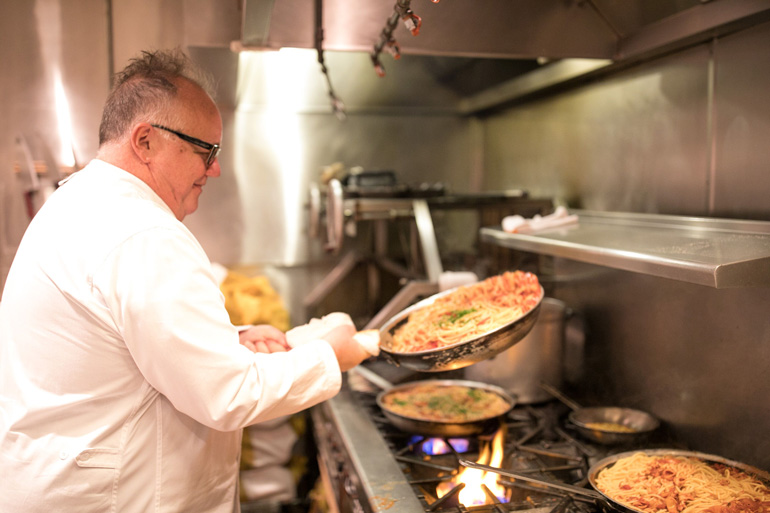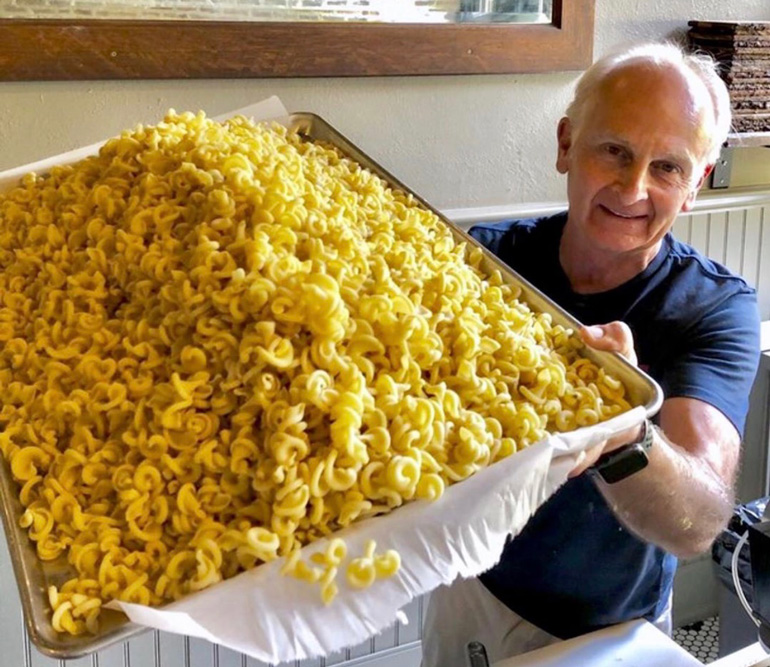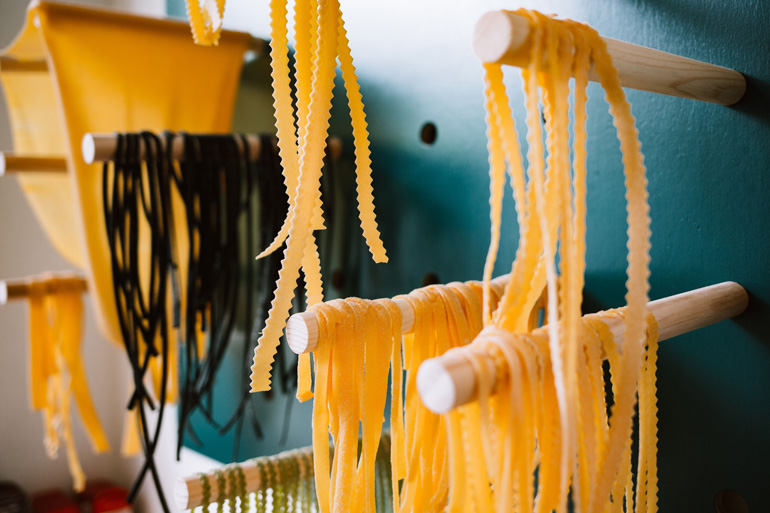Everyone loves pasta, right? That’s one reason why Chicago is now seeing a renewed interest in house-made, hand-crafted pasta.
At Spiaggia (980 N. Michigan Ave.), James Beard award-winning chef Tony Mantuano has been making pasta since day one. Sitting down before service one night in late October, Mantuano told us that in 1982, when he cooked at a restaurant called Pronto (200 E. Chestnut), “We made fresh pasta there in front of the restaurant and we’d hang it out in front to dry. At Spiaggia, when we first opened, our philosophy was to serve only fresh pasta.”

Spiaggia has been open for 35 years, and now there are many newer restaurants that have made pasta their signature dish. We talked to some local chefs about how they use the three elemental ingredients of water, flour, and egg to fashion the estimated 350 different shapes of pasta used to make the many thousands of different pasta dishes on restaurant menus around the world. It’s these chefs and restaurants, following in the chef’s clogs of people like Mantuano, who are driving a pasta renaissance in Chicago … and it isn’t all happening at strictly Italian restaurants.
“All the elements have to be right”
Bill Varley, Torchio

Last summer, we sat outside at Torchio Pasta Bar (738 N. Wells) and enjoyed the warm breeze and the beautiful pasta prepared by former engineer Bill Varley, who owns and operates the restaurant with his wife, Janice, and his sister, Jolene, a culinary school grad, formerly of Gourmet magazine’s executive dining room.
After a career in engineering, Varley set his sights on opening a restaurant that would serve the kind of handmade pasta he had prepared at home for his family … and particularly for his pasta-loving niece, Maggie. He and Janice happened upon a gorgeously solid early 20th century storefront on Wells, and that’s where, in May of this year, they opened the restaurant of their dreams.
Torchio, in case you’re wondering, is the name for a type of pasta press as well as the name of a curly, slightly twisted pasta that resembles a torch. Walking by the front door, you see the pasta being made in the window. All the pasta served at Torchio is, of course, made by hand. But Varley isn’t doctrinaire about the supremacy of fresh pasta, telling us, “There are very good dry pastas that actually work better with some sauces. But the texture, the chew and silkiness of fresh pasta, particularly with delicate sauces, is very different.”
Though Varley believes that in a good plate of pasta, sauce is neither more nor less important than the pasta itself — “all the elements have to be right” — his choice of pasta, he says, depends on the sauce that will accompany the pasta. “It’s fun making the torch-shaped pasta and the ‘little ears’ orecchiette, but my preference on any day is dictated by what dishes we’re serving and how the pasta will hold the sauce, how it works with the dish.”
Though Varley makes many of the traditional pasta shapes — bucatini, fettucine, rigatoni, and so on — he has the engineer’s spirit of discovery, and he’s always testing new ways of doing things. “I like experimenting with different shapes, and it’s gratifying when things come together in a final dish, and I see customers enjoying what I’ve made. We’re making over 200 pounds of pasta a week now, so that’s a good gauge that people are eating and liking it, and I enjoy making it for them.”

You can sense Varley’s excitement when he serves you a dish of his pasta, smiling slightly with anticipation, so happy to make you happy.
When we dined at Torchio, we had Giovanna’s Bolognese and enjoyed the flavor, of course, but we also appreciated that it was an old-style recipe prepared with a twist. As Varley explains, “It’s a traditional three-meat ragu with a touch of bechamel served in a plate-sized parmesan crisp. It’s a recipe we brought back from Bologna after meeting and working with a wonderful ‘Nonna,’ Giovanna Cardinali, in her home. Since we opened, it is the most consistently requested dish, and it’s not only delicious, but it also makes a beautiful presentation. It’s our showstopper, our signature dish, and a reminder to me of Italy, the people we met and the kind of Italian food I wanted to make in Chicago at Torchio.”
“Fresh pasta is a soulful product”
Duncan Biddulph, Tortello

It’s just a little confusing that Torchio and Tortello (1746 W. Division), both of which opened earlier this year, have names that sound similar and are both also names of pastas. Both Torchio and Tortello showcase world-class pasta-making skills, and each has a pasta person (or two) making the noodles in the window, which of course attracts many passersby.
Like Bill Varley, Tortello’s Executive Chef Duncan Biddulph believes, “Dried pasta has its place. It’s convenient, it’s shelf stable, and there are definitely good-quality brands.” Like many other makers of pasta, Biddulph believes “that fresh pasta is just a much better expression of what pasta is. From the texture to the flavor, it’s a different world. It expresses more character of the flour, the eggs, and the person who made it. Fresh pasta is a soulful product, and it takes textures to an even higher level. We’re able to respond to changes in moisture and let the ‘bounce back’ of the dough guide us.”

We asked Biddulph if “al dente” is actually the preferred way to eat pasta, and he told us that “there are no laws governing taste and one person’s al dente is another person’s overcooked. We try to cook the pasta just enough to bring out its flavor and texture best. Al dente translates to ‘to the tooth’ and that’s what we want; you should feel a toothsomeness to each bite. Cooking the pasta ‘al dente’ gives the pasta a starring role in the dish, not just as a carrier for sauce. The pasta is the point! It leads, and the sauce follows, but there is a symbiotic relationship between the two. You can’t just mix and match sauces and pastas. Each pasta is best suited for certain types of sauces based on its shape and texture; there’s a lot of joy in creating the right marriage.”
Before dining at Tortello, we spent a lot of time gazing in the front window to watch the pasta maidens making chiusoni, a rolled pasta that ends up looking like a small pinecone. The ridges on the chiusoni hold the sauce beautifully, and quite predictably, this pasta is a crowd pleaser. Chiusoni, says Biddulph, “is made from just flour and water, and it takes on a pleasantly toothy bite as it’s rolled across the back of a Parmigiana Reggiano cheese grater,” which gives the pasta balls a pinecone-like appearance.

The joy of making pasta is evident in Biddulph’s explanation that “you take these disparate ingredients (flour, eggs, water) and do the tactile work to bring them together into this incredible transformation. Something that you’ve created that will also nourish others. It’s amazing. We put a ton of labor into our pasta, but it’s a labor of love.”
“Letting the noodle speak for itself”
Joe Frillman, Daisies

Torchio and Tortello are both pasta-centric restaurants solidly within the Italian tradition. What makes Daisies (2523 N. Milwaukee) intriguing is that, though they’ve put house-made pasta front and center, they’re not what you’d think of as “an Italian place.” The genre in which they fit most comfortably is probably “New American,” but Italian food — pizza, pasta, etc. — are now so thoroughly ingrained in the American culinary canon that sometimes — as with pizza — there seems to be barely any light between what we think of as American food and what we think of as Italian food.
Those of us who make pasta at home usually buy dry pasta. There’s no doubt that high-quality dry pasta can be prepared to be almost as good as fresh pasta. But it will never be quite the same. As Daisies’ Chef/Owner Joe Frillman told us, what he likes about fresh pasta is “the richness and the varying textures. Most dried pasta doesn’t have egg, and egg really brings a richness and smooth chew to it.”
That focus on texture is reflected in Frillman’s belief, shared by most of us, that “pasta should never be overcooked. You’re always looking to maintain some texture to the noodle. Many times, it’s the only textural differentiation in the dish. The ‘al dente’ from a fresh noodle will be different than that of a dried noodle.”
At Daisies, one of Frillman’s favorite pasta preparations is truffle ravioli. “The filling is made from black truffle Robiola from Florence,” Frillman told us. “We rotate the sauce seasonally around the noodle, and you get some bold flavors, heavy on the umami, that guests really enjoy. And let’s face it: who doesn’t like black truffle. Outside of that, our most successful pastas focus on simplicity and letting the noodle speak for itself.”
To hear Frillman tell it, there’s an almost Zen-like state that he achieves when making pasta in the kitchen. “There’s something about zoning out and focusing on the repetition,” says Frillman, “that I thoroughly enjoy when rolling out the dough, especially for stuffed pastas. The feel of the dough and the attention to every detail really allows me to be present in that moment.”
“Joy in the Process of Creation”
When Mantuano makes pasta at home, he told us, “I like to have a lot of people around, so that everyone can pitch in and help. If we’re having a party, we make pasta. It’s fun and a centerpiece for the conversation. People love it; they get into it. And they’ll say, ‘I thought this would be so hard.’ But it isn’t hard!”
Many groceries and some restaurants, like Tortello, offer fresh pasta to bring home. If you go that route, Mantuano warns that when cooking the fresh pasta, don’t try to achieve the “al dente” texture that many consider the gold standard. “The ‘al dente’ designation applies specifically to dry pasta,” says Mantuano, “but fresh pasta doesn’t need to be al dente. A fresh pasta needs to be tender, and if it’s not tender, that takes away from the luxuriousness of fresh pasta.”
When presenting pasta, Mantuano, in the Italian tradition, recommends going easy on the sauce. “When you’ve twirled the last piece of pasta, there should be just enough sauce on the plate,” says Mantuano, “to take a piece of bread and scoop it up. There shouldn’t be a lot of sauce left after the pasta is gone.”
This Christmas holiday, you might consider getting the family together to make some pasta for dinner. Pasta making is, as Mantuano says, “fun … there’s joy in the process of creation.” And it isn’t hard.
 David Hammond is Dining and Drinking Editor at Newcity and contributes to the Chicago Tribune and other publications. In 2004, he co-founded LTHForum.com, the 15,000 member food chat site; for several years he wrote weekly “Food Detective” columns in the Chicago Sun-Times; he writes weekly food columns for Wednesday Journal. He has written extensively about the culinary traditions of Mexico and Southeast Asia and contributed several chapters to “Street Food Around the World.”
David Hammond is Dining and Drinking Editor at Newcity and contributes to the Chicago Tribune and other publications. In 2004, he co-founded LTHForum.com, the 15,000 member food chat site; for several years he wrote weekly “Food Detective” columns in the Chicago Sun-Times; he writes weekly food columns for Wednesday Journal. He has written extensively about the culinary traditions of Mexico and Southeast Asia and contributed several chapters to “Street Food Around the World.”
David is a supporter of S.A.C.R.E.D., Saving Agave for Culture, Recreation, Education and Development, an organization founded by Chicagoan Lou Bank and dedicated to increasing awareness of agave distillates and ensuring that the benefits of that awareness flow to the villages of Oaxaca, Mexico. Currently, S.A.C.R.E.D is funding the development of agave farms, a library and water preservation systems for the community of Santa Catarina Minas, Oaxaca.

